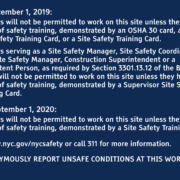Winter weather creates new challenges for employers trying to protect their employees from work-related accidents. Snow and Ice. How are you protecting your employees from potential slip and fall incidents related to snow and ice?  According to OSHA, 20% of all workplace injuries are due to trips, slips, and falls.
According to OSHA, 20% of all workplace injuries are due to trips, slips, and falls.
Types Of Cold Related Illness
Every year, around 1,330 people die of exposure to the cold. These deaths are preventable with the proper clothing. The four types of Cold related illnesses are hypothermia, frostbite, chilblains, and trench foot.
Hypothermia
When your body is exposed to cold temperatures, the body begins to lose heat faster than it can be produced. Prolonged exposure will eventually use up the body’s stored energy.
Signs of Hypothermia:
Early Symptoms
- Shivering
- Fatigue
- Loss of coordination
- Confusion and disorientation
Late Symptoms
- No shivering
- Blue skin
- Dilated pupils
- Slowed pulse and breathing
- Loss of consciousness
First Aid for Hypothermia
- Move employee to a warm room or shelter
- Remove their wet clothing
- Warm the center of their body first-chest, neck, head, and groin-using an electric blanket, if available; or use skin-to-skin contact under loose, dry layers of blankets, clothing, towels, or sheets.
- Warm beverages may help, but do not give alcoholic beverages. Do not try to give beverages to an unconscious person
- After their body temperature has increased, keep victim dry and wrapped in a blanket
- If the victim is unresponsive begin CPR
Frost Bite
Frostbite is caused by freezing. It causes loss of feeling and color in the affected areas. Frostbite most commonly affects the nose, ears, cheeks, chin, fingers, and toes. It can cause permanent damages to body tissue and severe cases can lead to amputation.
Symptoms:
- Reduced blood flow to hands and feet (fingers or toes can freeze)
- Numbness
- Tingling or stinging
- Aching
- Bluish or pale, waxy skin
First Aid
- Get into a warm room as soon as possible.
- Unless absolutely necessary, do not walk on frostbitten feet or toes-this increases the damage.
- Immerse the affected area in warm-not hot-water (the temperature should be comfortable to the touch for unaffected parts of the body).
- Warm the affected area using body heat; for example, the heat of an armpit can be used to warm frostbitten fingers.
- Do not rub or massage the frostbitten area; doing so may cause more damage.
- Do not use a heating pad, heat lamp, or the heat of a stove, fireplace, or radiator for warming. Affected areas are numb and can be easily burned.
Chilblains
Chilblains are the inflammation of blood vessels in the skin in response to repeated exposure to cold but not freezing air.
Symptoms
- Small, itchy red areas on your skin, often on your feet or hands
- Possible blistering or skin ulcers
- Swelling of your skin
- Burning sensation on your skin
- Changes in skin color from red to dark blue, accompanied by pain
First Aid
- Keep hands and feet warm and dry
- Wear gloves & socks
- Change damp gloves and socks when needed
- Move affected person inside
Cold related illnesses aren’t the only hazard that an organization faces with winter. Slip and fall injuries are more prevalent in the winter as well.






